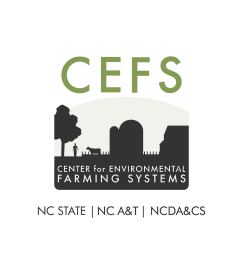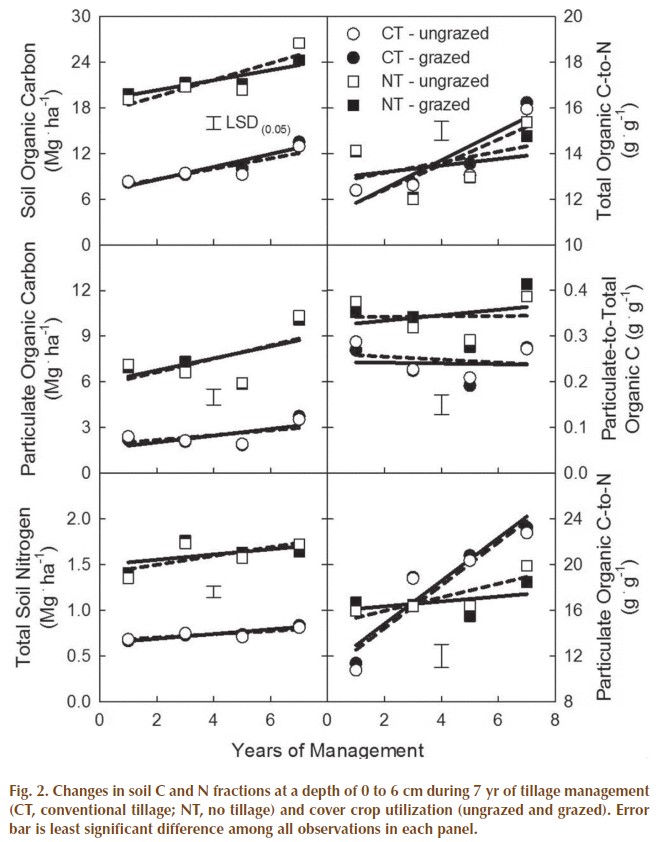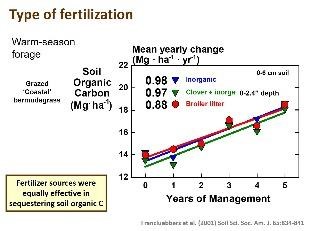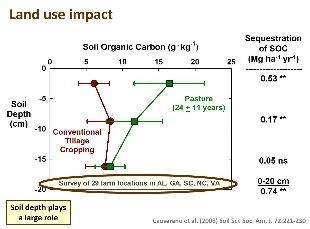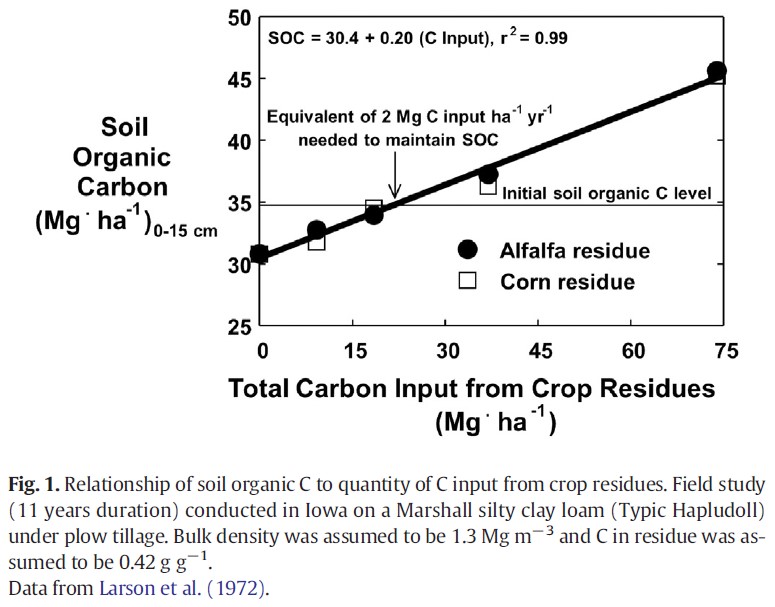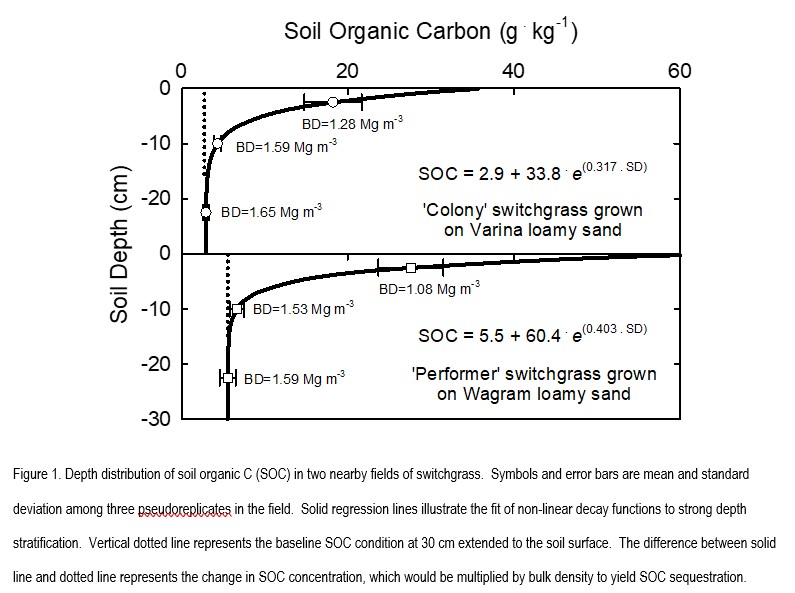Conservation Agricultural Management
Carbon plays a central role in conservation agriculture
Carbon is found in soil as organic matter and carbonate minerals (e.g. CaCO3). Soil organic matter is an assorted mixture of organic compounds, having been processed over varying lengths of time by soil organisms. It may be living (e.g. plant roots, insects, fungi, protozoa, or bacteria) or it may be dead, dying or partially decayed. The most abundant constituent of soil organic matter is carbon (~58%). Living components of soil organic matter make up a small percentage of organic matter (<10%), but play enormously important roles in decomposition, nutrient cycling, plant root zone modification, soil structural manipulation, aggregate stabilization, and ecological resilience through underground biodiversity development.
How does soil carbon affect ecosystem properties and services?
Soil organic carbon is a vital component of ecosystem properties, processes, and functions. It has highly relevant physical, chemical, and biological features. This wide diversity of features has given soil organic carbon deserved attention as a key indicator of soil health (i.e. how soil management affects the functioning of soil).
Attributes of soil organic carbon that affect soil and ecosystem properties include:
Physical
- Color: the dark color of organic matter alters thermal properties (i.e. absorbing heat)
- Low solubility: ensures that organic matter inputs are retained and are not rapidly leached from the soil profile
- Water retention: directly helps to absorb several times its mass of water and indirectly retains water through its effect on pore geometry and soil structure
- Stabilization of soil structure: binding of mineral particles to form water-stable aggregates and improve water infiltration into the surface soil
Chemical
- Cation exchange capacity: high charge enhances retention of nutrient cations, such as Al, Fe, Ca, Mg and NH4
- Buffering capacity and pH effects: avoids large swings in pH to keep acidity/alkalinity in a more acceptable range for plants
- Chelation of metals: complexation with metals to enhance dissolution of minerals, enhance avail- ability of phosphorus, reduce losses of micronutrients and reduce toxicity
- Interactions with xenobiotics: alter biodegrade-ability, activity, and persistence of pesticides and other organic contaminants, such as antibiotics and endocrine-disrupting chemicals
Biological
- Reservoir of metabolic energy: energy embedded in organic molecules to drive biological processes
- Source of macronutrients: mineralization of organic matter releases nitrogen, phosphorus, sulfur and other elements
- Enzymatic activities: both enhancement and inhibition of enzymes are possible by various humic materials
Ecosystem resilience: accumulation of soil organic matter can enhance the ability of an ecosystem to recover from various disturbances (e.g. drought, flooding, tillage, and fire)
Conservation agriculture has soil health principles at its core
Conservation agricultural systems have great potential to sequester soil organic carbon, which would help mitigate greenhouse gas emissions contributing to climate change and increase soil productivity and avoid further environmental damage from unsustainable use of inversion tillage systems – issues that threaten water quality, reduce soil biodiversity and erode soil around the world. Conservation
agricultural systems share the guiding principles of soil health:
- Minimize soil disturbance, consistent with sustainable production
- Maximize soil surface cover by managing crops, pastures, and crop residues
- Maximize opportunities for living roots with use of cover crops and intensive crop rotations
- Stimulate biological activity through crop rotations, cover crops and integrated nutrient and pest management
What type of research is being conducted?
Soil organic carbon sequestration is being calculated from farming systems with high crop residue, rotation with winter cover crops, diverse crop rotations, and perennial ground cover with grazed and hayed pastures.
Research studies have been conducted on both research stations over time and on farms with limited sampling over time, but intensive sampling with soil depth.
What research results have been found so far?
Soil organic carbon can be maintained at a high level in integrated crop-livestock systems with grazing of cover crops
- Soil organic carbon sequestration was significant in all of the diverse and intensive cropping systems but tended to be greater under no tillage (1.59 Mg C ha−1 yr−1) than under conventional tillage (1.00 Mg C ha−1 yr−1) at a depth of 0 to 30 cm
- Particulate organic carbon declined with time under conventional tillage (−0.49 Mg C ha−1 yr−1) and increased with time under no tillage (0.35 Mg C ha−1 yr−1) at a depth of 0 to 30 cm
- Total soil nitrogen sequestration occurred in the surface 6 cm and tended to be greater under no tillage (39 kg N ha−1 yr−1) than under conventional tillage (21 kg N ha−1 yr−1), but at the expense of declining nitrogen content deeper in the soil profile with no net change in total soil nitrogen at a depth of 0 to 30 cm
Source: Franzluebbers, A.J., & Stuedemann, J.A. (2014). Temporal dynamics of total and particulate organic carbon and nitrogen in cover crop grazed cropping systems. Soil Science Society of America Journal, 78, 1404-1413.
Soil organic C sequestration of managed pastures on six North Carolina farms
- Type of nitrogen fertilization doesn’t appear to be so important for rate of soil organic carbon sequestration – inorganic or organic sources give similar results in the southeastern US
- Grazing of pastures can accumulate soil organic carbon compared with haying or unharvested management
- Livestock behavior needs to be accounted, as there is significant lateral changes in soil organic carbon due to camping behavior near shade and water sources
- Greater stocks of soil organic carbon can be seen most clearly in surface soil, i.e. particularly the 0-10 cm depth
- Rates of soil organic carbon accumulation with pasture establishment are significant (~0.5 Mg C ha-1 yr-1 possible) and rates with better management of pastures may be nearly as large
- Rate of nitrogen fertilization on grazed pastures requires revision – responses are dependent on organic matter accumulation
Source: Franzluebbers, A.J. (2017). Carbon sequestration in US grazing systems. 3rd Conference of Greenhouse Gas Emissions in Animal Agriculture Production Systems of Latin America, 4-6 October 2017, Colonia, Uruguay.
Biofuel crops can be as effective as traditional pastures in storing soil carbon
- Bioenergy crops of sorghum, switchgrass, and giant miscanthus produced large yields
- Removal of N, P, and K was least for perennial bioenergy crops
- Perennial bioenergy crops had slightly poorer soil physical conditions after 3 years
- Organic C pools were greatest with giant miscanthus and fescue
Source: Wang, Z., Heitman, J.L., Smyth, T.J., Crozier, C., Franzluebbers, A.J., Lee, S., & Gehl, R.J. (2017). Soil responses to bioenergy crop production in the North Carolina Piedmont. Agronomy Journal, 109, 1368-1378.
Conservation agriculture approaches are needed to maintain ecosystem services
- Soil organic carbon influences a wide variety of soil chemical, physical, and biological properties that are important determinants of agricultural sustainability, including provisioning, regulating, supporting, and cultural services
- Soil organic carbon and associated properties and processes are influenced by land management, and therefore, achieving win–win strategies for productivity and environmental quality require diligent attention to underlying mechanisms controlling the balance between inputs and outputs of carbon
- Biofuel production from crop residues could avoid degradation on some highly productive soils, but not likely on many other soils in landscapes vulnerable to erosion and with limited soil organic matter to support internal nutrient cycling
- Perennial biomass feedstocks will be a more sustainable approach for biofuel production to avoid land degradation and improve land utilization of marginal areas
- Design of sustainable landscapes to accommodate food, feed, fiber, and fuel production has biophysical limitations, but also requires the input of a diversity of stakeholders, including farmers, communities, industries, and government policy makers
Source: Franzluebbers, A.J. (2015). Farming strategies to fuel bioenergy demands and facilitate essential soil services. Geoderma, 259, 251-258.
Pastures in rotation with crops have potential restore soil organic carbon across the agricultural landscape
- Soils rooted with perennial forages have high organic matter content, and therefore, can contribute to an agricultural future with high soil quality – a condition that can help to mitigate greenhouse gas emissions through soil carbon sequestration and improve a multitude of other ecosystem responses, including controlling water quality, improving water and nutrient cycling, and supporting biological diversity
- Agricultural soils will benefit from the re-introduction of perennial grasses and legumes into the landscape (i.e. temporally and/or spatially) by regaining soil organic matter and strengthening their capacity for long-term productivity and environmental resiliency
- A variety of pasture–crop rotation systems is envisioned – with and without direct animal grazing, intensity of grazing, species and nature of forages, position on the landscape, intensity and type of amendment application, frequency of renewal, and harvest intentions for food, feed, fiber, or fuel
- Widespread available data suggests that the food provisioning service of agriculture needs to be supported with appropriate conservation approaches, including utilization of perennial forages in pasture–crop rotations, for it to be fully functional and capable of meeting the growing demands on the Earth’s natural resources (i.e. soil, air, and water), as well as protecting the vital functions provided by these natural resources.
Source: Franzluebbers, A.J., Sawchik, J., & Taboada, M.A. (2014). Agronomic and environmental impacts of pasture-crop rotations in temperate North and South America. Agriculture, Ecosystems and Environment, 190, 18-26.
Unique calculation method of soil organic carbon sequestration compares favorably with traditional methods
- Soil organic carbon is highly stratified with depth in conservation systems in the southeastern US
- The surface 30 cm of soil contains the vast majority of management-induced soil organic carbon
- Soil organic carbon sequestration can be calculated from profile distribution of carbon
- No tillage cropland and pastures are significant sources of soil organic carbon sequestration
Source: Franzluebbers, A.J. (in review). Soil organic carbon sequestration calculated from depth distribution. Agronomy Journal

